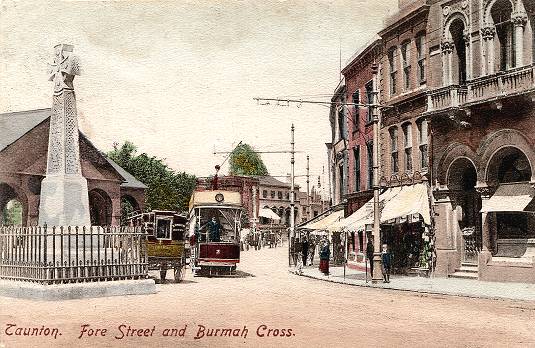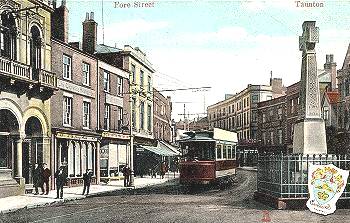

Our main postcard was published by Francis Frith and Co. of Reigate in 1902, in both colour and sepia versions numbered 48720. It remained on sale for many years, long after the double-deck trams were withdrawn and we have a copy posted in 1914. The card shows Fore Street with double-deck car 2 passing the Burma War Memorial, eastbound towards East Reach terminus. A 'London Hotel' horse bus is to the north of the memorial. The smaller postcard view below is at the same location but looking in the opposite direction. It shows single-deck car 1 westbound towards the original northern Station Road terminus, probably in late 1905 or 1906. It was card 2390 in the Milton "Glazette" series, published by Woolstone Bros of London E.C. It includes the town coat of arms, but this was not carried on the trams which had the British Electric Traction (BET) wheel and magnet emblem.
 After a false start in 1897, Taunton's tramway opened on 21st August 1901 with six new Brush double-deck cars during the high point of urban tramway construction. As normal for tramways in the West Country it was of 3ft 6ins gauge. It started with the longest tramway company name in the country as the "Taunton & West Somerset Electric Railways and Tramways Company". However, it was one of the shortest urban tramway systems in length and was only the second electric tramway in this country to close. After the abandonment of the earlier grandiose scheme to cover much of West Somerset, the name was shortened in 1903 to the "Taunton Electric Traction Co. Ltd.", as part of the BET Group. The line ran from the depot and eastern terminus in East Reach to the original northern terminus in Station Road just south of the low bridge of the Great Western Railway main line. Following many complaints the track was completely reconstructed in 1905. The double-deck cars went to the "Leamington & Warwick Tramway", another BET company, where they survived until 1930. These cars were replaced with six new Brush single-deck cars, more suitable for the light traffic. In 1909 the track was extended northwards under the GWR mainline bridge to a new terminus in Rowbarton, bringing the tramway to 1.66 miles in length. This was only possible after the introduction of single-deck cars.
After a false start in 1897, Taunton's tramway opened on 21st August 1901 with six new Brush double-deck cars during the high point of urban tramway construction. As normal for tramways in the West Country it was of 3ft 6ins gauge. It started with the longest tramway company name in the country as the "Taunton & West Somerset Electric Railways and Tramways Company". However, it was one of the shortest urban tramway systems in length and was only the second electric tramway in this country to close. After the abandonment of the earlier grandiose scheme to cover much of West Somerset, the name was shortened in 1903 to the "Taunton Electric Traction Co. Ltd.", as part of the BET Group. The line ran from the depot and eastern terminus in East Reach to the original northern terminus in Station Road just south of the low bridge of the Great Western Railway main line. Following many complaints the track was completely reconstructed in 1905. The double-deck cars went to the "Leamington & Warwick Tramway", another BET company, where they survived until 1930. These cars were replaced with six new Brush single-deck cars, more suitable for the light traffic. In 1909 the track was extended northwards under the GWR mainline bridge to a new terminus in Rowbarton, bringing the tramway to 1.66 miles in length. This was only possible after the introduction of single-deck cars.
The double-deck open-top cars (1-6) were built in 1901/2 by the Brush Electrical Engineering Co. Ltd. of Loughborough. They seated 22 passengers inside and 29 on top. They were on Brush 'A' 4-wheel trucks each with two Brush 800 17hp motors and Brush controllers. The single-deckers (also 1-6) of 1905 seated 24 and were also from Brush with similar trucks and controllers, but with two more powerful Brush 1002D 25hp motors. The livery was crimson lake and cream.
After WWI, disagreements with Taunton Borough Council over the price of power lead to it being switched off on 28th May 1921, with one tram apparently still left out on the track. Three single-deck cars went to Torquay for a one-man operated summer service, and two to Gravesend & Northfleet after having been re-gauged for 4ft 8½in track.
(Thanks to John Perkin for help with the historical text)
![]() Go to Postcard Of The Month Index
Go to Postcard Of The Month Index